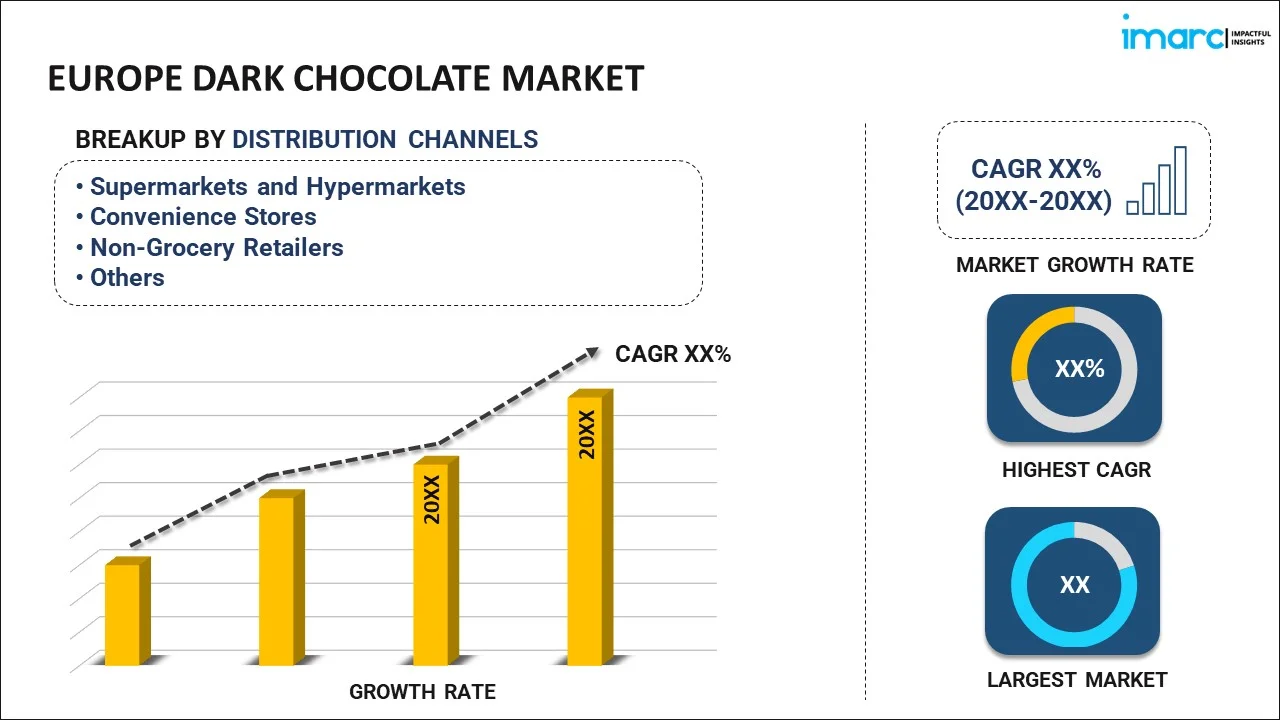
Europe Dark Chocolate Market Report by Distribution Channel (Supermarkets and Hypermarkets, Convenience Stores, Non-Grocery Retailers, and Others), and Country 2025-2033
Market Overview:
The Europe dark chocolate market size reached USD 28.1 Billion in 2024. Looking forward, IMARC Group expects the market to reach USD 34.9 Billion by 2033, exhibiting a growth rate (CAGR) of 2.32% during 2025-2033.
|
Report Attribute
|
Key Statistics
|
|---|---|
|
Base Year
|
2024
|
|
Forecast Years
|
2025-2033
|
|
Historical Years
|
2019-2024
|
|
Market Size in 2024
|
USD 28.1 Billion |
|
Market Forecast in 2033
|
USD 34.9 Billion |
| Market Growth Rate (2025-2033) | 2.32% |
Dark chocolate is a bittersweet or semisweet variation of chocolate. It is an excellent source of flavonoids and antioxidants, which contribute to its pigment and create a rich and intense flavor. Dark chocolate is used to manufacture a wide variety of products, including chocolate bars, candies and baking chocolate. In Europe, manufacturers have launched low-calorie, sugar-free and functional dark chocolates for health-conscious consumers across the region.
The Europe dark chocolate market is primarily driven by the increasing health consciousness among consumers as they have become more aware about the health benefits associated with the consumption of dark chocolate. It reduces blood pressure, improves blood flow to the brain and heart, and makes blood platelets less sticky and non-agglomerated. It also increases good cholesterol (HDL) levels and protects LDL against oxidation, thus lowering the risk of cardiovascular diseases. Besides this, the rising popularity of organic dark chocolate has prompted manufacturers to incorporate organic ingredients and natural sweeteners, thereby positively impacting the market. Moreover, market players are introducing new dark chocolate packs with a longer shelf life and reduced transportation risks to attract price-sensitive consumers.
Key Market Segmentation:
IMARC Group provides an analysis of the key trends in each segment of the Europe dark chocolate market report, along with forecasts at the regional and country levels from 2025-2033. Our report has categorized the market based on distribution channel.
Breakup by Distribution Channel:

- Supermarkets and Hypermarkets
- Convenience Stores
- Non-Grocery Retailers
- Others
Breakup by Country:
- Germany
- France
- United Kingdom
- Italy
- Spain
- Others
Competitive Landscape:
The competitive landscape of the industry has also been examined along with the profiles of the key players.
Report Coverage:
| Report Features | Details |
|---|---|
| Base Year of the Analysis | 2024 |
| Historical Period | 2019-2024 |
| Forecast Period | 2025-2033 |
| Units | Billion USD |
| Scope of the Report | Exploration of Historical and Forecast Trends, Industry Catalysts and Challenges, Segment-Wise Historical and Predictive Market Assessment:
|
| Distribution Channels Covered | Supermarkets and Hypermarkets, Convenience Stores, Non-Grocery Retailers, Others |
| Countries Covered | Germany, France, United Kingdom, Italy, Spain, Others |
| Customization Scope | 10% Free Customization |
| Post-Sale Analyst Support | 10-12 Weeks |
| Delivery Format | PDF and Excel through Email (We can also provide the editable version of the report in PPT/Word format on special request) |
Key Questions Answered in This Report:
- How has the Europe dark chocolate market performed so far and how will it perform in the coming years?
- What has been the impact of COVID-19 on the Europe dark chocolate market?
- What are the key regional markets?
- What is the breakup of the market based on the distribution channel?
- What are the various stages in the value chain of the industry?
- What are the key driving factors and challenges in the industry?
- What is the structure of the Europe dark chocolate market and who are the key players?
- What is the degree of competition in the industry?
Need more help?
- Speak to our experienced analysts for insights on the current market scenarios.
- Include additional segments and countries to customize the report as per your requirement.
- Gain an unparalleled competitive advantage in your domain by understanding how to utilize the report and positively impacting your operations and revenue.
- For further assistance, please connect with our analysts.

 Inquire Before Buying
Inquire Before Buying
 Speak to an Analyst
Speak to an Analyst
 Request Brochure
Request Brochure
 Request Customization
Request Customization



.webp)




.webp)












